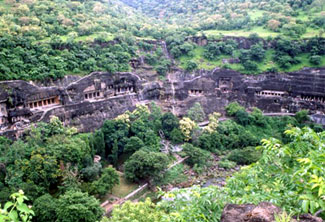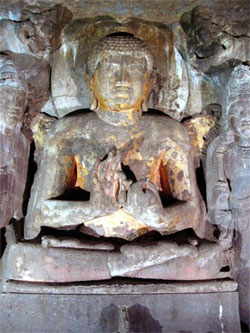Apr 20, 2024
Apr 20, 2024
 Carved out of the austere rocks of central India's Sahyadri mountains are a breathtaking set of grottos that depict life over eight centuries. As world heritage monuments go, the Ajanta and Ellora caves in the western Indian state of Maharashtra - about 400 km from Mumbai - are unique because they capture the evolution of a remarkable culture for such an extended period and freeze it for posterity in rocks that survive over two millennia later.
Carved out of the austere rocks of central India's Sahyadri mountains are a breathtaking set of grottos that depict life over eight centuries. As world heritage monuments go, the Ajanta and Ellora caves in the western Indian state of Maharashtra - about 400 km from Mumbai - are unique because they capture the evolution of a remarkable culture for such an extended period and freeze it for posterity in rocks that survive over two millennia later.
Declared a UNESCO World Heritage Site in 1983, the allure of the caves and the sculptures and paintings inside them has grown steadily. Unlike India's most famous monument, the Taj Mahal, the set of 50-some caves between Ajanta and Ellora offer a dramatic peek inside life as it unfolded over centuries.
Built between 200 B.C. and 600 A.D by a series of dynasties, the caves remained forgotten until 1819 when a British hunting expedition, on the trail of some tigers, chanced upon one cat contrasting against the giant horseshoe monument.
 Made by chiseling through the enormous horseshoe shaped hard rock on the Waghure River, the caves were ancient resting places for Buddhist monks traversing the length and breadth of the country to propagate Buddhist philosophy.
Made by chiseling through the enormous horseshoe shaped hard rock on the Waghure River, the caves were ancient resting places for Buddhist monks traversing the length and breadth of the country to propagate Buddhist philosophy.
The caves consist of 'vihars' (cells to rest) and 'chaityas' (prayer halls) and are full of stunning Buddhist style paintings that encapsulate the various incarnations of Gautam Buddha known as Jataka Tales.
Although historians and archaeologists have always recognized the importance of the caves, it is only in recent years that a joint effort between the Maharashtra Tourism Development Corporation, the Archaeological Survey of India and the Japan Bank for International Cooperation (JBIC) has begun to transform them into a comprehensive tourist site.
One of the most daunting challenges for those in charge of the upkeep of the caves has been the preservation of such a rich record of ancient history even while keeping it accessible to tourists.
Faced with the contradictory choice of preserving and popularizing the 2,200-year-old Ajanta and Ellora caves with their treasure trove of paintings, the authorities have now deployed an architectural, design and multimedia solution devised by Mumbai architect couple Trilochan and Anju Chhaya.
Five kilometres away from the magnificent monument, the architects have decided to create a "prelude" to the caves.
"Think of it as a trailer to a grand epic movie. It should be tantalizing without giving anything away. Our challenge has been to create an experience which is authentic, informative and exciting for an increasing number of tourists who visit both the Ajanta and Ellora caves," Chhaya told IANS.
"When we look at the Ajanta and Ellora caves we are really looking at the evolution of nearly 1,000 years in terms of culture. Paintings, jewellery, costumes, culinary rituals, fashion have all been depicted in these paintings. As an architect my biggest challenge was to offer visitors a complete overview of this grand spectacle without really trying to impress them with my design. I approached the project with a great deal of humility," the architect added.
The project, costing upwards of Rs. 1 billion ($22.5 million), aims at cushioning and significantly minimizing the impact of tourism on the site without in anyway curtailing the tourist inflow.
Before doing that, authorities went about the task of transforming the infrastructure in and around the caves with new roads, electricity lines, afforestation and transportation.
A one-armed helical spiral galaxy like structure is now taking shape away from the caves where designers plan to offer a multimedia experience built around replicas of four caves. Stories, drawn from the history of the monument, will be narrated using multimedia techniques.
Chhaya said he has taken care to see that his team does not try to "show off" and approaches the whole project with "humility and a sense of paying tribute to the ancient masters".
Paintings and carvings from the caves are being replicated and placed in the upcoming building with the specific purpose of "satiating" people's curiosity before the reach the actual heritage site.
"We believe this approach will help in preserving the original masterpieces. Additionally, we are also creating a sort of sculptor's studio, which will sell replicas of the cave structures and paintings. This too will help deflect unwanted attention to the actual monument," he said.
The whole experience at the new building will begin at the Orientation Centre, which will prepare tourists on what to expect. Located under a 100 ft dome resting on a cylinder, the centre will house a cyclorama projector for a powerful audiovisual experience. Then there is the replica of the caves, complete with the paintings. The third element will be the multimedia centre embedded between the cave replicas.
While the Ajanta Visitor Centre concentrates on the paintings, the Ellora version focuses on the actual cave structure. Together they offer a comprehensive insight into centuries of cultural evolution. Both the complexes will have a series of short films being played in loop, offering the visitors a continuing primer in the history of what they are about to enter.
The designers have ensured that they incorporate the four famous features of the region such as the Paithani saris, Himru linen, black metal Bidri work and stoneware as part of the experiences. Local artisans will make these products at the site.
As part of their plan to retain thematic consistency, the design firm CCDC has created a layout for the new airport at the nearest town of Aurangabad.
"The idea is to offer anyone coming to Aurangabad a sense of having entered a place of extraordinary history right from the airport. It is a fusion of the modern shell with traditional interiors depicting a changing and modernizing face of the city," Chhaya said.
The Ajanta and Ellora Visitor Centre has the potential to emerge as a model for preservation for a large number of heritage sites not just in India but for all over the world.
A team of British experts that saw the project design went back thoroughly impressed with the idea that perhaps Britain's famous Stonehenge, the Neolithic and Bronze Age monument dating back to 2500 BC, could use a similar preservation solution.
30-Mar-2007
More by : Mayank Chhaya